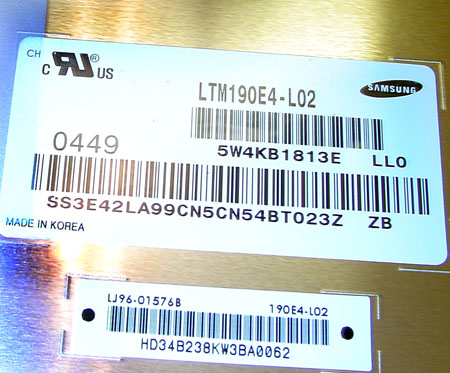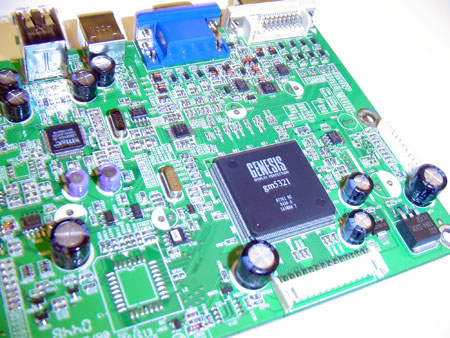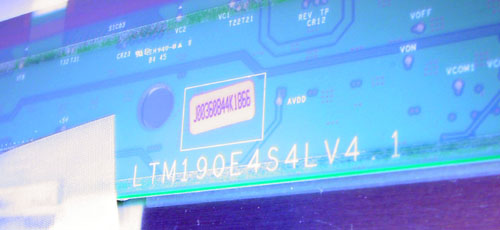Dell UltraSharp 1905FP: Setting the Bar for New 19" LCDs
by Kristopher Kubicki on January 29, 2005 12:35 AM EST- Posted in
- Displays
Genesis gm5321
At the heart of every good LCD monitor revolves around a great signal processor – and our Dell 1905FP is no exception. The Genesis gm5321 found in the Dell 1905FP acts as the unified analog and digital controller for everything on the monitor except sound and USB. According to the technical documentation, the Genesis gm5321 is HDCP capable – so you should be able to hook up a DVI-HDCP receiver or DVD player to the monitor without worries.

Our monitor did not come with any sound capability, so that controller does not exist on the PCB. In the upper left corner of the board, you can see the SMC USB controller.
The ribbon connector just below the Genesis DSP provides the input for the LCD panel while power from the separate inverter comes across the plug along the right side of the board.
Samsung LTM190E4
The cornerstone of our Dell 1905FP is the superb Samsung LTM190E4 panel.

Interestingly enough, after opening the monitor, some of the modulation PCB from the panel was directly exposed, but sheathed in a protective film. The components of an LCD panel are almost always sheathed behind metal EMI shields.
The Samsung website currently advertises a 1000:1 contrast ratio for the panel, which is probably a little too inflated. The original Samsung 193P used the same panel, but only advertised an 800:1 contrast ratio, and Dell advertises the 1905FP with an 800:1 contrast ratio as well. Given the liberal techniques that manufacturers use to measure contrast ratios, we are surprised that panel manufacturers haven't inflated ratios more since abominable plasma displays claim 2000:1 ratios.
But contrast ratio aside, the thing that sets this panel apart from most is that it's a lower response time component utilizing a genuine 8-bit panel with a PVA display mode. We always recommend 8-bit LCD panels over 6-bit LCD panels whenever possible, so immediately, the panel appeals to us. The PVA display mode is proprietary to Samsung, but it also appeals to us more than the prevalent TN display mode in use on most 6-bit panels today; the viewing angle is wider and the gray-to-gray transient is actually lower in many cases.
Our panel came with zero pixel or subpixel defects.












66 Comments
View All Comments
hoppa - Saturday, January 29, 2005 - link
i hardly see the point in spending so much extra money going from 17" to 19" if you are not going to be afforded any extra resolution.Thermopyle - Saturday, January 29, 2005 - link
"It's my personal belief that the transient time between two current generation LCD monitors is practically impossible in real world applications, but everyone has different levels of sensitivity on the matter."This sentence is confusing. I assume by transient time you mean response time, but I don't understand what the "transient time between two LCD monitors" means. Then you say the transient time is "impossible". Huh? What is impossible?
The whole sentence makes me want to cry.
KristopherKubicki - Saturday, January 29, 2005 - link
It is 5:4 not 4:3 - this has been updated.Dell did not have any samples of the 2005FPW for us. I am guessing if they don't have samples for PR, they are probably changing something on the monitor.
Hope that helps,
Kristopher
drifter106 - Saturday, January 29, 2005 - link
I am somewhat puzzled by this statement...We were not able to get a sample of the 2005FPW in time for this review
I am sitting here looking at one and I know they have been out for some time. I am disappointed that you would make a statement like that. Could a better choice of words been used to substantiate as to why you chose NOT to include the 2005? The last thing I would hope to hear from this site is something that makes me doubt your authenticity.
jd
Fionavar - Saturday, January 29, 2005 - link
Thanks for the review. I do want to echo someone earlier - where is the long for and much anticipated review of the 2005FPW? This monitor is clogging others boards with discussions and it would WONDERFUL to have something definitive from AnandTech!REMF - Saturday, January 29, 2005 - link
i wouldn't touch a dell box, but i will happily buy their excellent screens.i wouldn't buy any M$ software, but they make bloody good mice.
even bad companies (subjective opinion) can make great products.
Mojo027 - Saturday, January 29, 2005 - link
I wish you guys wouldn't rip on the BenQ monitor so much, it's really a great monitor. You should be comparing the FP937 12ms monitor to these models, not the FP931 16ms...However, great article, and I'm sure the Dell models are great.
Gnoad - Saturday, January 29, 2005 - link
Why? Dell makes quality LCD screens and cheap basic computers for the average person. Just because we can build our own for the same price with twice the performance does't mean they're a bad company.TwistyKat - Saturday, January 29, 2005 - link
I don't care how great it might be - I would never buy anything Dell.Spacecomber - Saturday, January 29, 2005 - link
Like #11, I too found the sentence he or she quoted ambiquous.I'm glad to hear, as noted in the review, that there continue to be LCDs affordable monitors being produced that are closing the gap between a LCD that produces a full range of color and LCDs that are fast enough for gaming.
It will be intresting to see if Dell can do a good job of keeping up with the demand for this monitor and resist the temptation to raise the price as its popularity grows. Anandtech's reviews no doubt carry a fair amount of clout when it comes to influencing consumers. I'm sure many others also noticed how quickly the NuTech L921G sold out just about everywhere and how the Viewsonic Q190MB went from being a bargain priced monitor to a premium priced model.
My guess is that someone else is putting together the L921G for Nutech. It would be very interesting to know who this and who else they are providing monitors to.